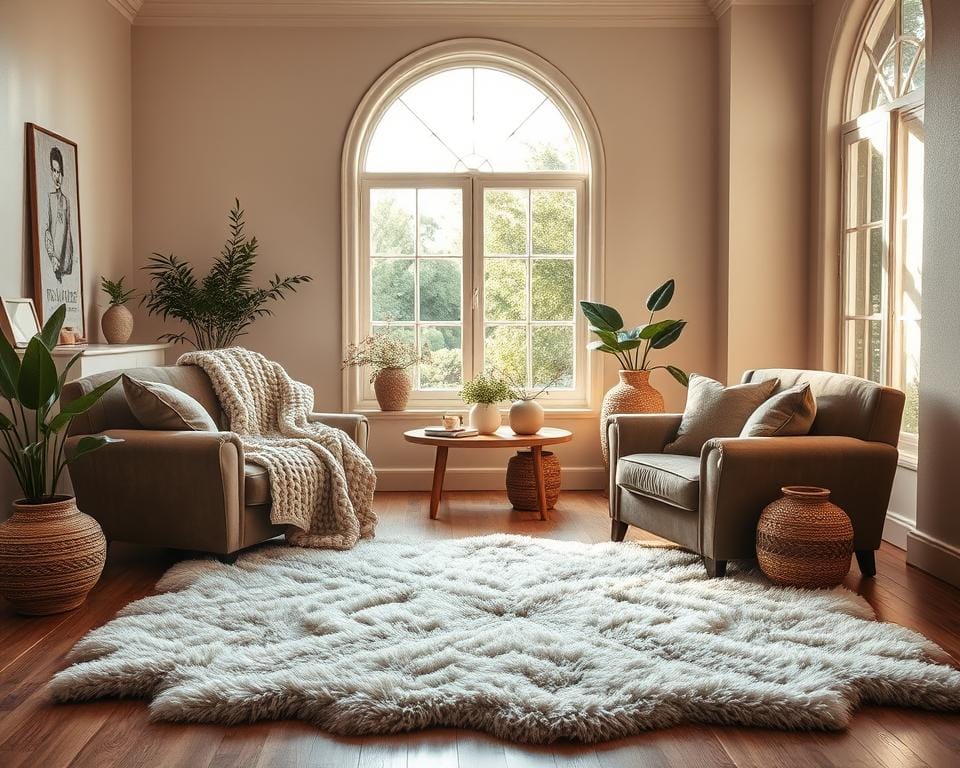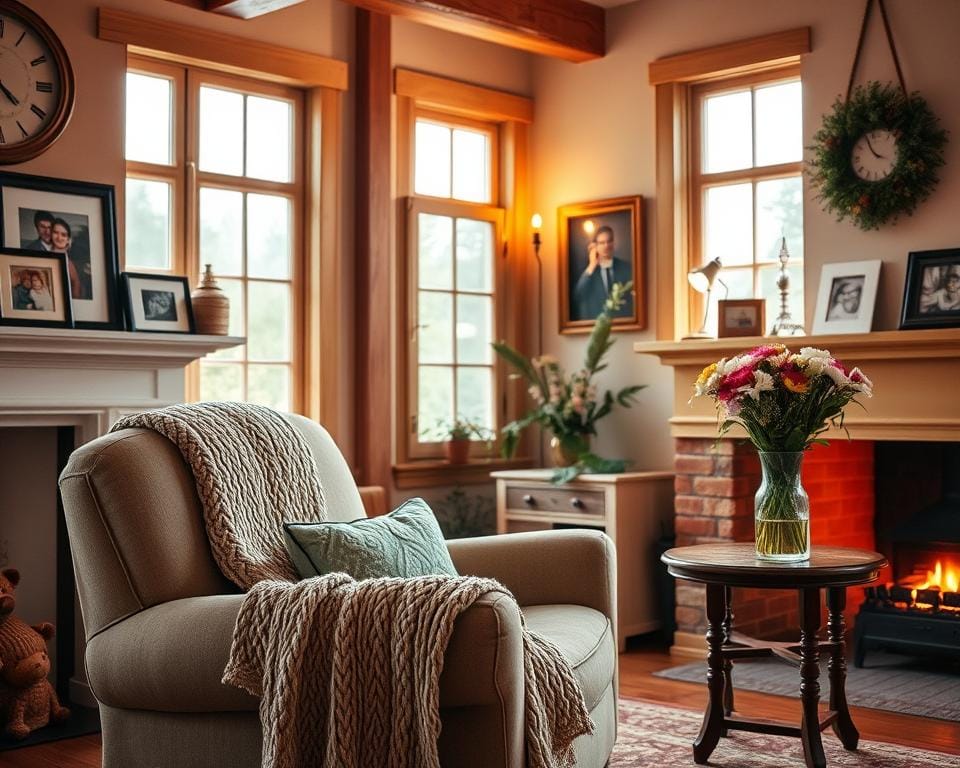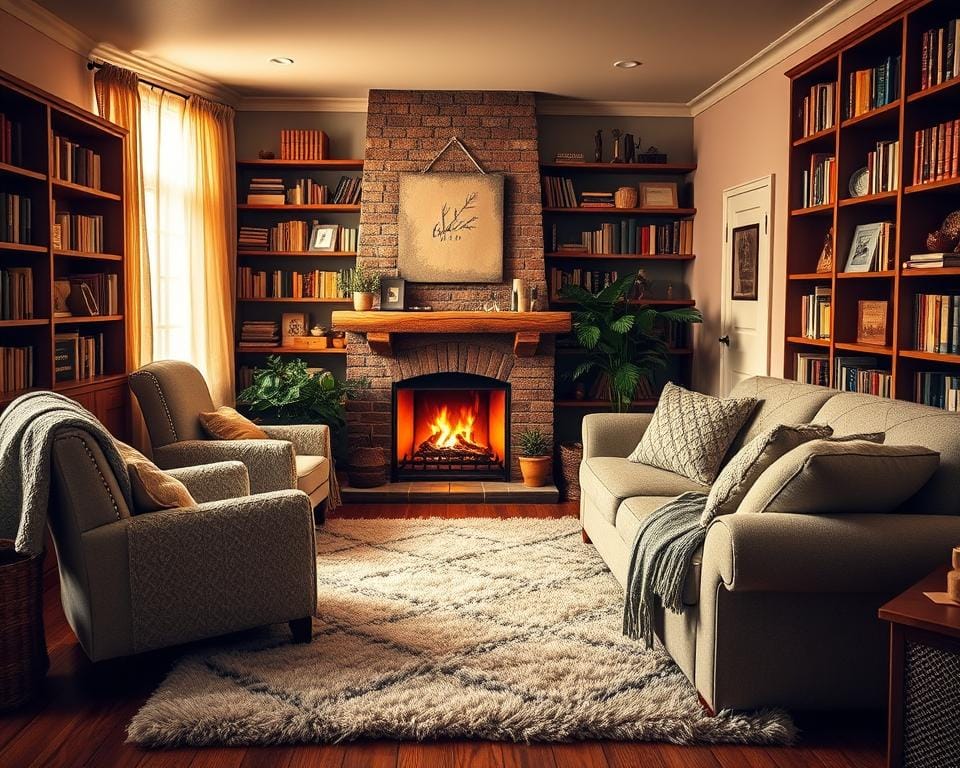When did we start believing that comfort requires endless spending? I’ve discovered that true warmth in a living space comes not from price tags, but from thoughtful details that whisper “you belong here”. Your refuge from the world begins with embracing imperfections – that slightly crooked photo frame or the well-loved blanket your gran knitted.
The magic lies in layering textures that invite touch. Think chunky knits draped over armchairs or a sheepskin rug underfoot. Lighting plays its part too – swap harsh overhead bulbs for table lamps casting golden pools of light. These elements create spaces that feel lived-in rather than staged.
Key Takeaways
- Prioritise comfort over current interior trends
- Use layered lighting to create warm atmospheres
- Incorporate meaningful personal items naturally
- Choose practical furnishings that encourage relaxation
- Embrace imperfections as character-building features
My favourite trick? Keeping a basket of throws by the sofa – instant snugness for impromptu film nights. Remember, it’s about crafting spaces that reflect your story, not replicating showroom perfection. The true test comes when you kick off your shoes and genuinely relax – that’s when you know you’ve nailed it.
Setting the Scene for a Cosy Haven
The journey to creating calm spaces began when my living room became a nursery overnight. I realised home isn’t about Instagram-worthy corners – it’s where sticky fingerprints and mismatched cushions tell our family’s story.
My journey to creating calm spaces
Early motherhood taught me that spaces must serve real life. I swapped delicate decor for washable rugs and open baskets for toy storage. The shift from “show home” to living space wasn’t about lowering standards, but prioritising peace. Now, our kitchen table hosts both work emails and finger paintings – and that’s perfectly okay.

Why a cosy home matters to me
During lockdowns, our home became the ultimate safe haven. It’s where we’ve weathered storms – literal and metaphorical. I’ve learnt that family-friendly design means choosing robust fabrics over delicate ones, and leaving room for spontaneous dance parties. The magic happens when people feel free to exist authentically in their surroundings.
Three lessons from my experience:
- Rooms used daily deserve the same care as guest areas
- Mental health improves when spaces encourage relaxation
- Practical choices often lead to the warmest atmospheres
Embracing Warmth Through Personal Touches
My sofa confession? Every seat in my house doubles as a nap zone. If you can’t properly sprawl with a cuppa, it’s just decoration. That’s why Welsh wool blankets live permanently draped over chairs, and a woven hamper by the telly stores our cosy arsenal – machine-washable throws for impromptu duvet days.

Transforming a house into a home feel happens when spaces work for real life. I choose squashy armchairs over pristine ones, because saggy cushions mean someone’s been laughing there. The best seats have:
- Textures that beg to be touched (think cable knits or fleece-lined throws)
- Armrests wide enough for tea mugs and biscuit plates
- Blankets within reach – no one should hunt for warmth
My secret weapon? A £12 Primark throw that’s survived three winters of dog cuddles and red wine spills. Warmth isn’t about price tags – it’s that sigh of relief when you flop onto a sofa and find a soft layer already there. These touches make people linger longer, turning “I’ll just pop round” into proper catch-ups.
True comfort means designing for slumped postures and socked feet. When your bed’s the only cosy spot, you’re doing it wrong. Layer seating areas with practical softness, and watch how people instinctively relax – that’s when a house becomes a haven.
How to Curate a Cozy Home
I once visited a friend’s house where every surface felt intentionally inviting – not because of expensive art, but through clever use of what they already owned. That experience taught me that transforming rooms begins with observing how you actually live in them. Start by asking: “Where do my shoulders relax first when I walk in?”
Simple decor ideas that invite warmth
Natural materials work wonders for adding character. A rattan basket under the coffee table stores magazines while bringing earthy texture. Try pairing white walls with oak shelves displaying well-loved books – the contrast creates visual comfort without clutter. My go-to trick? Swapping out metallic hardware for leather drawer pulls in the bedroom.
Three rules I follow:
- Choose wooden side tables over glass – they feel warmer to the touch
- Layer rugs (jute underfoot, sheepskin draped over chairs)
- Use terracotta pots for plants to introduce rich, organic tones
Cosy lighting techniques for a relaxing atmosphere
Overhead lights are for finding lost earrings – not for daily living. I use table lamps with 2700K bulbs in every seating area. Position one behind your shoulder when reading to reduce eye strain. For evening movie nights, plug-in wall sconces cast flattering shadows while keeping floors clear.
My lighting checklist:
- Install dimmer switches – they’re renter-friendly and transformative
- Use upward-facing lights in corners to bounce warmth off ceilings
- Group tea lights on mirrored trays for instant festive vibes
The magic happens when your living areas adapt to different moods. That slightly worn armchair by the window? Perfect for rainy afternoons with a novel. By focusing on how each space gets used – not just how it looks – you create rooms that feel like gentle exhales.
Utilising Vintage Finds and Personal Treasures
My front door once led into a space that felt like every other house on the street. That changed when I began hunting for vintage treasures – suddenly, our rooms started whispering stories instead of echoing showroom catalogues. The secret? Letting each find earn its place through meaning, not just aesthetics.
Mixing thrifted pieces with modern accents
I’ve found that 70/30 works best – 70% modern foundations, 30% characterful vintage touches. A sleek sofa gets paired with a 1970s side table, while minimalist shelves display Depression-era glassware. This balance stops spaces feeling like museum exhibits while adding textural depth.
| Aspect | Vintage Approach | Modern Complement |
|---|---|---|
| Furniture | Reupholstered armchair (1960s) | Modular sofa |
| Lighting | Brass pharmacy lamp | LED track lighting |
| Textiles | Hand-embroidered cushions | Performance fabric curtains |
My best finds came from unlikely spots – church jumble sales, eBay collections, even skip-rescued wood shelves. The key? Knowing what makes your heart skip. That chipped Victorian picture frame? It’s now our favourite bathroom mirror.
Build your house’s personality gradually. I spent six months finding the right 1920s bureau – but that hunt made finally placing it sweeter. Homes layered over time feel genuinely welcoming, like a well-worn leather jacket versus stiff new denim.
Three rules I live by:
- Let oddities shine – a mismatched door handle becomes a talking point
- Mix wood tones intentionally (walnut tables + oak floors)
- Display functional vintage – use that art deco bowl for keys
Your house becomes a home when it cradles both your daily rhythms and history. Those things you’ve collected aren’t just decor – they’re bookmarks in your life’s story.
Enhancing Ambience with Low-Level Lighting
Nothing kills a relaxed evening faster than glaring overheads. I’ve learnt that gentle illumination works like a warm hug for your living rooms – it’s about crafting pools of light where life unfolds comfortably.
The lamp lover’s manifesto
Side lamps are my secret weapon. Position upward-facing ones in corners to wash walls with golden light (60W bulbs work best). For reading nooks, downward-facing models with 75W keep pages crisp without eye strain. Pro tip: place a lamp near your favourite armchair and one by the window to balance natural and artificial lighting.
Candlelit magic made simple
Unscented candles transform meals into occasions – cluster three on a tray for instant sophistication. Outdoors, battery-powered string lights draped over fences create starlit vibes without fire risks. My rule? Always light candles before guests arrive – that first flickering glimpse through the door sets the mood perfectly.
True lighting mastery lies in layers. Combine table lamps, dimmers, and the occasional candle to build spaces that feel softly alive. When shadows dance rather than dominate, you’ve created rooms that breathe with you.

